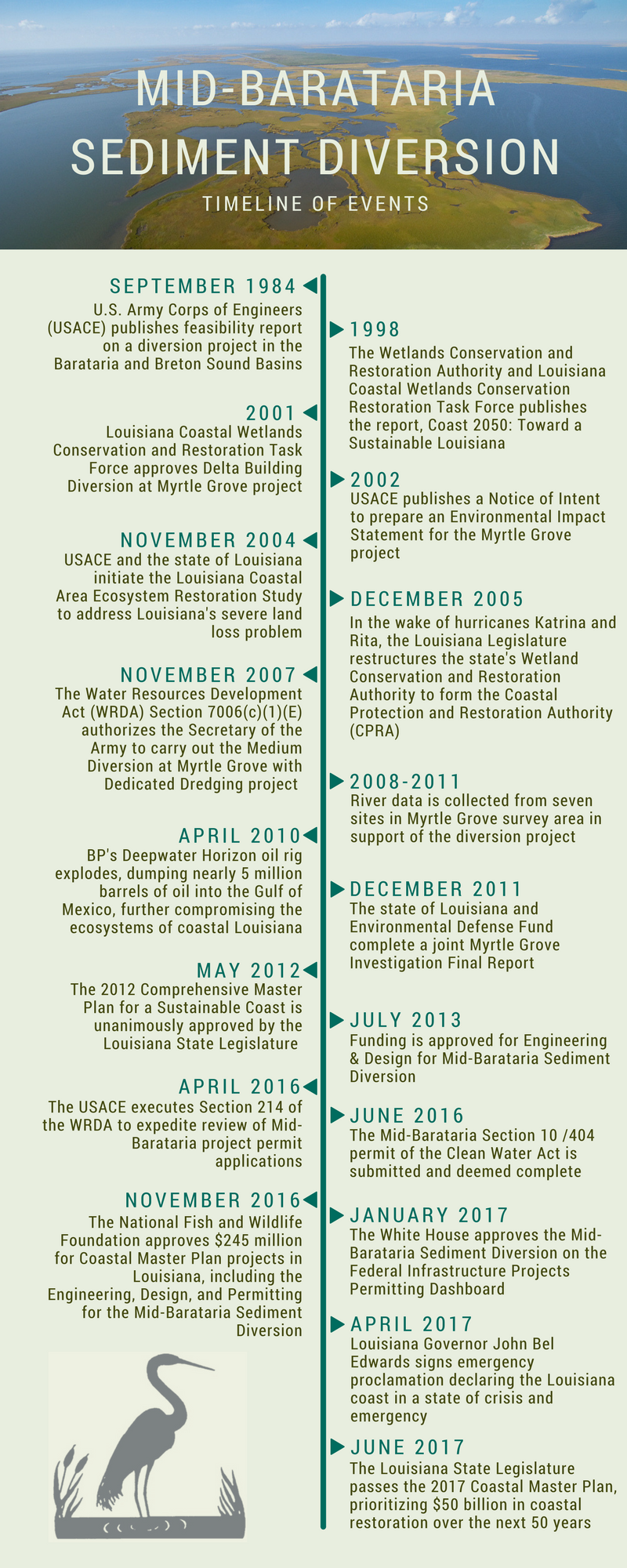The History of the Mid-Barataria Sediment Diversion

Meghan Fullam working to educate kids about the environment
As an individual working and studying in the interior United States, I have always been passionate about the assessment and quality of rivers, from the Snake River in Wyoming to the Schuylkill in Pennsylvania. Using the geography of interior waterways, I have worked as an environmental educator and taught students about watersheds and the importance of healthy water resources considering the growing demands of agriculture, industry and urban centers.
And yet, there has been no river more powerful than the Mississippi in assembling a narrative that intertwines with the plight of these societal demands. The need to understand and work with the flow of this charismatic river is growing ever more important, and as a new intern aboard the Mississippi River Delta restoration team at Environmental Defense Fund, I have learned that one project ambitiously aims to do so: the Mid-Barataria Sediment Diversion.
The History of Mid-Barataria Sediment Diversion
Working on the Mid-Barataria Sediment Diversion’s initial scoping process has opened my eyes to the nuances of science-driven policy and the importance of coalition advocacy. Reviewing the journal articles, reports, presentations, memos, letters, agendas and notes regarding this project has helped me better understand the issues surrounding coastal Louisiana restoration. It also allowed me to observe and appreciate the immense amount of research that has been put into the refinement of this particular wetlands-building project.

Teaching students about watersheds and a healthy environment
The scoping of this project began with the first feasibility study published in 1984, laying out 16 plans for introducing freshwater and sediment diversions into the Barataria Basin. The placement of a diversion at Myrtle Grove, LA was one of many locations proposed in a subsequent 1987 report. A 1998 report titled Coast 2050: Toward a Sustainable Louisiana offered a single plan for the coast and integrated a multiple-use approach to ecosystem management, proposing several large diversions in the Barataria Basin for marsh and barrier island restoration.
A diversion project began to more fully take shape under the Coastal Wetlands Planning, Protection, and Restoration Act (CWPPRA) in 2001, and in 2004, a Louisiana Coastal Area (LCA) study identified the Medium Diversion at Myrtle Grove as a “near-term critical restoration feature” project. Ongoing research from 2008 to 2011 collected site-specific river data such as bathymetry, water discharge, currents and grain size at seven locations in the Myrtle Grove survey area to determine the best location for a large-scale sediment diversion.
Using the collected river data and an understanding of the land-building capacity within Barataria Basin, the location of the intake channel and outfall channel alignment for Mid-Barataria was carefully selected in 2011 at river mile 60.7 to optimize the capture of sediment from the river.
From Planning to Implementation
More recent sediment diversion history is grounded in the 2012 Coastal Master Plan, which the Louisiana State Legislature unanimously approved. The plan prominently recommended the Mid-Barataria Sediment Diversion located at Myrtle Grove as a priority project to reintroduce sediments and nutrients to the Barataria Basin.
Over the past five years, the Mid-Barataria Sediment Diversion has entered into the lengthy processes of the National Environmental Protection Act (NEPA) process and U.S. Army Corps of Engineers regulatory permitting. In 2016, funding was secured for the engineering, permitting, environmental data collection, and stakeholder engagement of the Mid-Barataria through a grant from the National Fish and Wildlife Foundation (NFWF).
The recently passed 2017 Coastal Master Plan sets sediment diversions, such as Mid-Barataria, as a cornerstone of the plan and states that “Louisiana stands ready to harness the power of the strongest tool available to build and sustain land – the Mississippi River.”
The Mid-Barataria Sediment Diversion, in conjunction with many other coastal restoration projects, aspires to use the Mississippi River as a foundation for sustaining the ecosystems, commerce, energy resources, recreation and culture that have uniquely come to define coastal Louisiana as we know it.
Working as an intern on the Mississippi River Delta Restoration team is an incredible opportunity to refine my passion for water-based conservation and advocacy and to observe some of the greatest science and policy minds collaborate and provide feasible solutions to our nation’s most beloved waterway.
View this timeline of the Mid-Barataria Sediment Diversion below:
Allison, M. (2011, November). Water and Sediment Surveys of the Mississippi River Channel Conducted at Myrtle Grove and Magnolia in Support of Numerical Modeling (Rep.). Retrieved https://cims.coastal.louisiana.gov/RecordDetail.aspx?Root=0&sid=19553#
Coast 2050: Toward a Sustainable Coastal Louisiana (Rep.). (1998). Retrieved http://www.lawater.lsu.edu/docs/2943_coast2050.pdf
Conner, W. H., & Daly, J. W., Jr. (1987, July). The Ecology of Barataria Basin, Louisiana: An Estuarine Profile (Rep.). Retrieved https://www.nwrc.usgs.gov/techrpt/85-7-13.pdf
Environmental Defense Fund. (2017, June 2). Louisiana Legislature Approves 2017 Coastal Master Plan [Press release]. Retrieved from https://www.edf.org/media/louisiana-legislature-approves-2017-coastal-master-plan?utm_source=twitter&utm_campaign=edf_content-share_upd_web&utm_medium=referral&utm_id=1443643165
Louisiana Coastal Area: Feasibility Report on Freshwater Diversion to Barataria and Breton Sound Basins (Rep.). (1984). Retrieved https://biotech.law.lsu.edu/blog/EIS-LCA_Fresh-Div-Barat-and-Breton-Sound-Basin_Feasibility-Study_Volume-1.pdf
Myrtle Grove Delta Building Diversion Modeling Effort in Support of the LCA Medium Diversion at Myrtle Grove with Dedicated Dredging Project (Rep.). (2011, December 12). Retrieved file:///C:/Users/mfullam/Downloads/4900753-1%20(5).pdf
